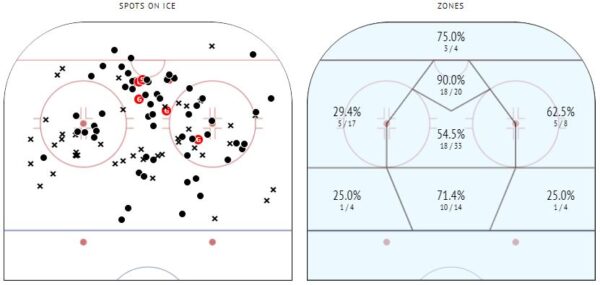Analytics Approach: Gleb Trikozov
Welcome to FCHockey’s “Analytics Approach” Series that takes a deep dive on 2022 NHL Draft prospects from the perspective of possession and shot attempts. Driving play through carrying the puck and putting the puck in high danger areas are critical traits to becoming not just NHL players, but superstars as well.
In this edition, I tracked the puck possession metrics for winger Gleb Trikozov of Omskie Yastreby of the MHL.
I tracked four games by Trikozov and totalled up his metrics to see what patterns developed as I watched him play. The games tracked are noted below and all metrics are tabulated at 5-on-5, even strength:
- November 7th, 2021 against Sputnik
- November 8th, 2021 against Sputnik
- December 4th, 2021 against Avto
- December 7th, 2021 against Avto
Trikozov, No. 30 in FCHockey’s Winter ranking for the 2022 draft, has the makings of a power forward who can create offense on his own and drive transition by carrying the puck. He seems to be well aware of the physical advantage he has over players at the junior level in Russia, as he wins puck battles by using his body and also protects the puck well when skating with it.
What is fun to watch about Trikozov is how well he processes the game, especially in the offensive zone. He thinks the game very well, understanding what’s happening around him and changing his position on the ice to put him in areas that allow him to have space.
In the above clip, Trikozov helps create the zone entry by drawing multiple defenders towards him in the neutral zone before dishing it off to a teammate. He then maintains some space following the play up so as to not go into the very crowded slot. As the puck goes into the corner, Trikozov takes an excellent angle to the defensemen and catches him off guard, stealing the puck with ease.
This play by Trikozov highlights his high end processing ability to anticipate where the play is going and putting himself in a good position to regain possession of the puck.
When talking about how well a prospect processes the game and their hockey IQ, it really pertains to the decisions they make both with and without the puck. Putting himself and teammates in better positions to have possession of the puck and maintain possession is a key aspect to Trikozov’s game that shows up on tape and the micro stats.
In the clip above, Trikozov finds open ice in his own end and supports his defender. When he gets the puck, Trikozov is well aware that he doesn’t have much time to make a play and knows where his teammate is breaking out. A quick turn and simple pass gets the puck out of the zone. While it wasn’t the cleanest exit, Trikozov showed the ability to make quick decisions with the puck that also maintained possession for his team.
In the following clip, he gains entry and makes a quick stop, creating space between himself and the defender. This opens up a shooting lane for Trikozov who has a forward driving to the net for a rebound.
While the outcome doesn’t result in a goal, the thought process here to create room for himself and quickly identify a chance to get the puck to the net is the key takeaway from Trikozov’s game. Anticipation and position are what enables this quick exit pass by Trikozov.
Blocking a passing lane and having the discipline to stay in his zone makes things easy for Trikozov when the puck bounces out to him. His awareness of a teammate breaking out of the zone enables him to get a quick pass out accurately and turn the rush up ice.
Trikozov then follows the play up down the middle of the ice and gets a scoring chance. The zone exit itself is a nice play, but to continue on into the other team’s zone and put himself in a position to receive a pass in the high-danger area of the ice is yet another example of Trikozov’s smarts. As the speed of the game gets quicker at higher levels of play, this ability for Trikozov to diagnose the game around him will come in handy. Making prompt decisions will help him adapt and have success as he develops.
Below is a glossary of terms used for this tracking effort which should look familiar to those with some experience in analytics. The focus in this article is on puck possession and the shot attempts associated with them to better understand how impactful a player is on shot attempts for and against.
Glossary:
SA For – Shot Attempts For
SA Against – Shot Attempts Against
CF% – Percentage of Shot Attempts For (Team and Opponent)
SC For – Scoring Chances For
SC Against – Scoring Chances Against
SCF% – Percentage of Scoring Chances For (Team and Opponent)
Primary Shot Assist – Pass that leads to a Shot Attempt
Puck Possession Metrics:
| Controlled Entries | 16 | Controlled Exits | 12 |
| Dump-Ins | 1 | Uncontrolled Exits | 1 |
| Failed Entries | 2 | Failed Exits | 1 |
| Entry Rate (%) | 84.2 | Exit Rate (%) | 85.7 |
Trikozov showed through these games that he is exceptional at carrying the puck through all three zones with success, rarely having an issue executing transition plays. Part of this is due to playing in the MHL, however, these tendencies are traits that translate well to the NHL and having the confidence to carry the puck is promising for Trikozov’s future.
Generally speaking, Trikozov was the biggest contributor for his team in either exiting his zone or entering opponent territory with control of the puck.
In this next clip, he doesn’t enter the zone with a lot of speed and stays very calm with the puck. Another brilliant example of how well Trikozov understands the game, he patiently waits for support from his teammates.
A few subtle stickhandling moves allow Trikozov to hang onto the puck and reposition himself to make a pass to a teammate coming in with speed. It’s a simple play, but so intelligent because it would be easy for a player to skate into the corner and limit his options. Instead, Trikozov used a change of direction to dictate the play.
It’s a reoccurring theme. Trikozov is a key contributor to driving transition for his team. While the previous clip showed him slowing the game down on a zone entry, this next one displays the speed Trikozov has.
Anticipating where the puck is going off the faceoff and accelerating immediately allows Trikozov to catch the opponent off guard. By keeping his feet moving, he’s able to carry the puck through all three zones and create separation — which ultimately ends in a scoring chance.
In the clip above, Trikozov enters the offensive zone and allows his team to get into position down low by hanging onto the puck. As he dishes it down into the corner, Trikozov then drives to the high slot where he is fed a return pass.
The key with Trikozov’s ability to transition play into offense is that he’s also creating shot attempts and scoring chances because of his decision-making. The team shot attempt metrics didn’t favor Trikozov’s team at a high level, though the quality of the shot attempts certainly were much greater for his team than the opponent.
Note: The metric of shot quality is sometimes captured in a stat called expected goals, though for this article, this data is not available and as such is generalized.
Team & Individual Shot Attempt Metrics:
| SA For | 40 | Primary Shot Assists | 6 |
| SA Against | 44 | Passes To Slot | 4 |
| CF% | 47.6 | Individual Shot Attempts | 16 |
| SC For | 5 | Individual Shots on Goal | 8 |
| SC Against | 3 | Player Isolated Contribution to CF (%) | 55 |
| SCF% | 62.5 |
After viewing these games, it was no surprise to see Trikozov’s individual contributions to shot attempts be so high. He was clearly the biggest impact to creating shots and scoring chances for his team. Accounting for over 50% of his team’s primary shot attempts is evidence of just how much the puck is on his stick and the good decisions he makes with it.
In this next video, he does a great job staying with his man and preventing a high quality shot attempt against. The patience by Trikozov is impressive as is his timing on when to apply quick pressure to the puck carrier, forcing them to make a decision with the puck early.
To give a better view of where Trikozov is taking his shots from, InStat Hockey has a shot map for this season to date. All shot attempts in the map below are at 5-on-5 and include shots on goal as well as shot attempts that missed the net or were blocked.

As expected, Trikozov takes a majority of his shot attempts from in tight. He also is not hesitant to take shots from further out either, which is a testament to him identifying opportunities to throw the puck towards the net when there are screens in front.
Creating primary shot attempts like the play above makes Trikozov a dynamic player who can be a positive impact to shot attempts whether he’s shooting or passing. Trikozov does such a great job at quickly processing whether he or a teammate would have a better chance at a shot attempt and typically makes the appropriate decision with a positive end result.
In the clip below, Trikozov really puts on a nice display of several of his skills. Short area quickness, patience with the puck, creating scoring chances, and winning puck battles, just to name a few.
While it may be easy to chalk some of what Trikozov is doing to easier competition in the MHL, there’s no denying his skill set or hockey instincts.
Trikozov has made a strong case to be selected in the back end of the first round in the upcoming 2022 NHL Draft. Should he fall further than that though, he will absolutely be considered excellent value as a player who projects to be a middle-six role in the NHL.

